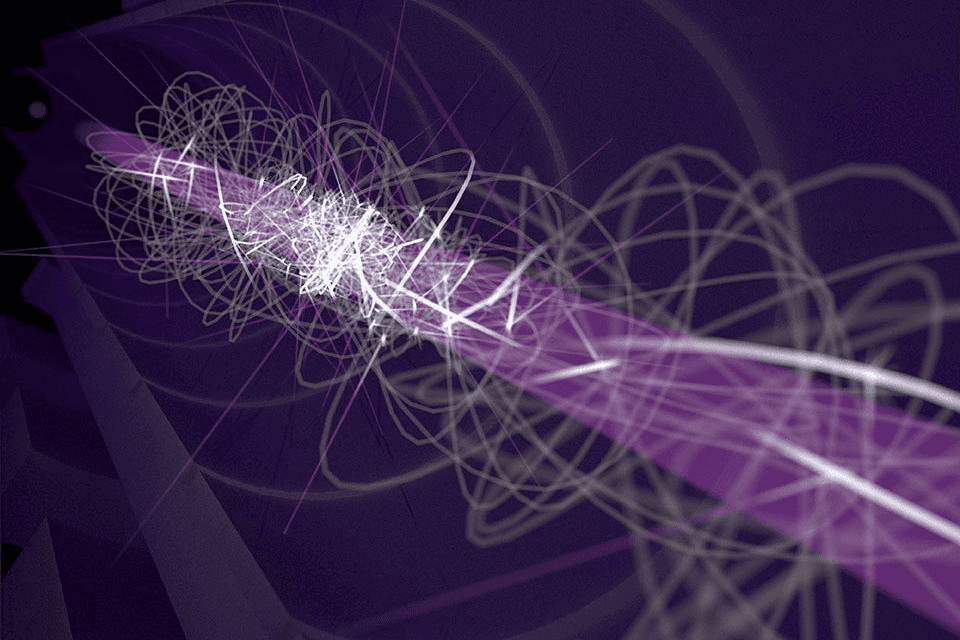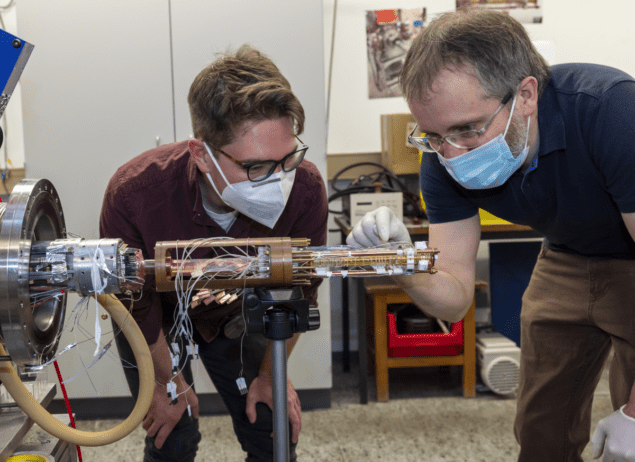Proton cooled using an ion cloud and superconducting circuit
06 Sep 2021
The ability to trap charged particles and cool them down to a fraction of a degree above absolute zero is key to many tests of fundamental physics, including probes of any asymmmetry between matter and antimatter. To reach lower temperatures more quickly, physicists in Germany and Japan have now shown how to extract heat from a single proton via a superconducting circuit connected to a cloud of laser-cooled ions several centimetres away – a technique, they say, that could easily be applied to antiprotons.
The Standard Model of particle physics tells us that all physical processes must obey CPT symmetry, leaving them unchanged when charge, parity and time are all reversed. Violation of this symmetry would require an overhaul of the Standard Model and might also explain why the universe appears to be made up almost entirely of matter even though equal quantities of matter and antimatter ought to have been created in the Big Bang.
The Baryon Antibaryon Symmetry Experiment (BASE) is one of several experiments at the CERN in Switzerland that studies antimatter using antiprotons delivered by the lab’s Antiproton Decelerator. Its specific goal is to look for evidence of CPT violation by comparing the magnetic moments of protons and antiprotons, having so far established that the two quantities are equal at the level of 1.5 parts in a billion.
Sympathetic cooling
In the latest work, members of the BASE collaboration have demonstrated a new technique for cooling protons and antiprotons that should allow them to make even more precise comparisons of the particles’ magnetic moments. The technique involves the laser cooling of beryllium ions, a process that relies on light absorption to chill ions down to just a few thousandths of a degree above absolute zero. This cooling cannot be applied to protons and antiprotons directly as these subatomic particles lack electronic structure. Instead, the researchers exploit what is known as sympathetic cooling to chill protons using the cold beryllium ions.
The idea is to cool one charged particle by bringing it in thermal contact with another charged particle at a lower temperature. This can be done with a positively-charged ion – being progressively cooled by lasers – and a proton held using electric and magnetic fields in the same trap. The two particles repel each other and in the process the proton transfers heat to the ion, thereby cooling.
Since the ions used in laser cooling are usually formed by stripping otherwise neutral atoms of their electrons, the technique cannot be used to cool antiprotons – which have a positive charge – using a single trap. The novelty in the new research is to show how a subatomic particle can be sympathetically cooled even though it is in a different trap to the ions.
Superconducting LC circuit
BASE, led by Stefan Ulmer of RIKEN in Japan, demonstrated its approach in a laboratory at the University of Mainz in Germany – using protons rather than antiprotons for the moment. The experiment consists of two Penning ion traps some 9 cm apart, both of which are connected to a cryogenic inductor–capacitor (LC) circuit. A single proton is stored in one of the traps and a cloud of laser-cooled beryllium ions in the other. The resonant frequency of the superconducting LC circuit is set close to the axial frequencies of the traps, which makes it possible to transfer energy via the circuit from the proton to the ions.
As they report in a paper in Nature, Ulmer and colleagues used two experimental signals to show that the ions really did cool the proton. For one thing, they were able to work out the temperature of the two particle systems by analysing electrical noise present in the LC circuit. At the same time, they varied the resonance frequency of the ions while keeping that of the proton fixed. As expected, they observed cooling only when the ion frequency matched the frequencies of both the proton and the circuit.
Seconds, not hours
The team found that they could reduce the proton’s temperature by 85%, cooling it resistively to 17 K and then down to about 2.5 K. Ultimately, by improving coupling times and trap geometry in future experiments they hope to achieve temperatures of a few tens of milliKelvin within just a few seconds. That compares favourably with the roughly 10 h it previously took them to cool antiprotons to about 100 mK, which they did by coupling a cooled superconducting resonator and then painstakingly siphoning off the particles with the lowest energies.READ MORE

These lower temperatures, says Ulmer, should allow them to probe matter-antimatter symmetry “at much improved precision”. As to how precisely, he would not say. Neither will he be drawn on the precision that might realistically be needed to see potential CPT symmetry violation. That, he says, is a “purely speculative” question.
Writing a “News and views” article in Nature to accompany the research, Manas Mukherjee of the National University of Singapore says that the new technique raises the prospect of being able to cool any charged particle – at arbitrarily large distances – by “wiring it up” to laser-cooled ions. He adds that the scheme might also provide a better way of exchanging single bits of quantum information than using quantum states of emitted light. But he cautions that the rate of energy exchange between particle systems will first need to “greatly improve”.
FROM PHYSICSWORLD.COM 6/9/2021

Δεν υπάρχουν σχόλια:
Δημοσίευση σχολίου